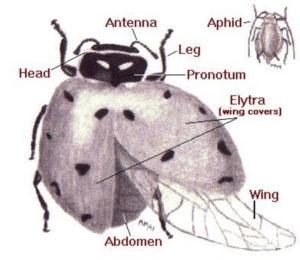Lost Ladybug Project: Content Resources for Teachers
Although some of the resources in this guide offer guidance for classroom instruction and student materials, these resources are primarily intended for teacher use. If shared with students, some of this information may inhibit their sensemaking opportunities in the monthly activities.
All About Ladybugs
- NC State Extension (2015, February 23) Lady Beetles (Ladybugs).
- Goforth, C. (2009, June 28). All bugs are insects, but not all insects are bugs. The Dragonfly Woman.
- Goforth, C. (2011). Taxonomy, or How the Biological World is Organized. The Dragonfly Woman.
- Goforth, C. (2012). Scientific Nomenclature, or How Biological Organisms are Named. The Dragonfly Woman.
Ladybugs in the Winter
- Goforth, C. (2013, February 11). What Time it is in Nature: Winter Ladybugs. Museum Blogs: North Carolina Museum of Natural Sciences.
- Izlar, R. (2018, February 16). Why You See Lady Beetles in Your House During Winter. PBS North Carolina.
- Knapp, M., Řeřicha, M. (2020). Effects of the winter temperature regime on survival, body mass loss and post-winter starvation resistance in laboratory-reared and field-collected ladybirds. Scientific Reports, 10(1).
- Panko, B. (2017, February 15). What Do Insects Do in Winter? Smithsonian Mag: ASKSmithsonian.
- Department of Systematic Biology, Entomology Section, National Museum of Natural History, in cooperation with the Smithsonian Institution. Information Sheet Number 65: Where Do Insects Go in the Winter? (2021).
Population Decline
- Stephens, E.S., & Losey, J.L. (2002). Coccinella novemnotata, Nine Spotted Lady Beetle. Cornell University Insect Conservation Biology.
- The Lost Ladybug Project. (2018). C. novemnotata in Decline.
Other
- Damalas, C. A. (2009). Understanding benefits and risks of pesticide use. Sci. Res. Essays, 4(10), 945-949.
Ladybug Anatomy
 Source: http://www.lostladybug.org/files/anatomy.JPG
Source: http://www.lostladybug.org/files/anatomy.JPG